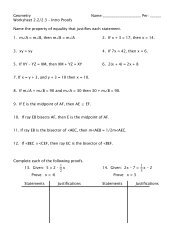Chapter 1: Charting the Heavens - Saratoga High School
Chapter 1: Charting the Heavens - Saratoga High School
Chapter 1: Charting the Heavens - Saratoga High School
Create successful ePaper yourself
Turn your PDF publications into a flip-book with our unique Google optimized e-Paper software.
<strong>Chapter</strong> 1:<br />
<strong>Charting</strong> <strong>the</strong> <strong>Heavens</strong><br />
1.3: Constellations<br />
In this chapter we explore how <strong>the</strong> universe appears from our<br />
vantage point on Earth.<br />
People have been observing <strong>the</strong> sky for thousands of years. Many<br />
groups of people through history have named various groupings of<br />
stars as constellations. The stars in a constellation do not usually<br />
have any association with one ano<strong>the</strong>r except that <strong>the</strong>y make a<br />
pattern as seen from Earth.<br />
1
1.3: Constellations<br />
There are 88 constellations in <strong>the</strong> sky; 44 of <strong>the</strong>m were<br />
named in ancient times (Mesopotamian, Babylonian,<br />
Egyptian, Greek.) They represent such things as animals,<br />
heroes, and goddesses. These 44 don’t cover <strong>the</strong> whole<br />
sky.<br />
They miss: 1) regions of sky with no bright stars<br />
– 2) <strong>the</strong> far sou<strong>the</strong>rn sky<br />
Modern astronomers created 44 more<br />
constellations to fill in <strong>the</strong> gaps between <strong>the</strong><br />
ancient ones, so that every part of <strong>the</strong> sky falls<br />
within <strong>the</strong> boundaries of a constellation. This is<br />
because many astronomical objects are named or<br />
located based on <strong>the</strong> constellation in which <strong>the</strong>y<br />
are found.<br />
1.3: Constellations<br />
2
1.3: Constellations<br />
One example of this is stars. Stars are named in<br />
two ways: individual names (for <strong>the</strong> brightest stars<br />
only) and based on constellation. Within a<br />
constellation, stars are named with greek letters,<br />
beginning with alpha (α) as <strong>the</strong> brightest, beta (β)<br />
as <strong>the</strong> second brightest, and so on. So <strong>the</strong><br />
brightest star in <strong>the</strong> constellation Taurus, named<br />
Aldebaran, is also known as α Tauri. These<br />
designations were made in ancient times for <strong>the</strong><br />
original 44 constellations, so <strong>the</strong>y aren’t always<br />
completely accurate.<br />
3
Brightness<br />
The brightness of objects is measured using<br />
apparent visual magnitude. The magnitude<br />
scale is an inverse scale: lower numbers mean<br />
brighter objects. It describes how bright <strong>the</strong><br />
stars look to human eyes (which does not<br />
necessarily relate to how much light <strong>the</strong>y put<br />
out). Amateur astronomers use this scale more<br />
than professional astronomers. Astronomers<br />
use an Intensity scale which measures <strong>the</strong><br />
amount of light energy that hits 1 square meter<br />
in 1 second.<br />
Object<br />
Magnitude<br />
Sun<br />
Moon (full)<br />
Sirius ( <strong>the</strong> brightest star in <strong>the</strong><br />
sky)<br />
Dimmest star visible from<br />
<strong>Saratoga</strong><br />
Dimmest star visible to <strong>the</strong><br />
Hubble Space Telescope<br />
-26.5<br />
-12.5<br />
-1.4<br />
+5 to +6<br />
+28<br />
4
The Celestial Sphere<br />
• Our model of <strong>the</strong> sky as seen from Earth is called <strong>the</strong><br />
celestial sphere – a large imaginary sphere that surrounds<br />
<strong>the</strong> planet to which all celestial bodies seem to be attached.<br />
We only see half of this sphere at any given time, <strong>the</strong> rest<br />
is below <strong>the</strong> horizon, where sky meets Earth.<br />
• On <strong>the</strong> celestial sphere we have reference marks to guide<br />
us in <strong>the</strong> sky. There are north & south celestial poles –<br />
points in <strong>the</strong> sky directly above <strong>the</strong> north & south poles of<br />
Earth. These points appear motionless in <strong>the</strong> sky, as <strong>the</strong><br />
celestial sphere rotates around <strong>the</strong>m.<br />
There is a celestial equator, <strong>the</strong> imaginary line directly<br />
above <strong>the</strong> Earth’s equator.<br />
The Celestial Sphere<br />
5
Angular Measure<br />
• To measure distances in <strong>the</strong> sky we use angles, measured in<br />
degrees arc minutes & arc seconds.<br />
In 1 o <strong>the</strong>re are 60’ and in 1’ <strong>the</strong>re are 60”<br />
These angle measurements are used to describe separations,<br />
diameters, and elevations of objects in <strong>the</strong> sky.<br />
If you extend your arm, <strong>the</strong> width of your index finger ≈ 1 o<br />
while <strong>the</strong> width of your fist ≈ 10 o<br />
Precession<br />
• We generally think of <strong>the</strong> celestial sphere as fixed,<br />
but it isn’t. The celestial poles slowly move across<br />
<strong>the</strong> sky, as if <strong>the</strong> Earth is wobbling like a top. This<br />
is called precession. The celestial poles make a<br />
circle through <strong>the</strong> sky, taking 26,000 years to<br />
complete one cycle.<br />
6
Seasonal Changes<br />
• There is one more important line we must draw<br />
on <strong>the</strong> celestial sphere: <strong>the</strong> ecliptic. This is <strong>the</strong><br />
path that <strong>the</strong> sun appears to follows through <strong>the</strong><br />
sky. The sun is in a slightly different location in<br />
<strong>the</strong> sky each day due to <strong>the</strong> Earth’s motion around<br />
<strong>the</strong> sun. The tilt of <strong>the</strong> Earth’s axis causes <strong>the</strong><br />
ecliptic to curve through <strong>the</strong> sky ra<strong>the</strong>r than<br />
follow a straight line.<br />
7
Seasonal Changes<br />
• There are 4 special points on <strong>the</strong> ecliptic that relate<br />
to our terrestrial seasons:<br />
• vernal equinox – where <strong>the</strong> sun crosses <strong>the</strong> celestial<br />
equator moving northward – <strong>the</strong> start of spring<br />
• summer solstice – <strong>the</strong> sun’s nor<strong>the</strong>rnmost point in<br />
<strong>the</strong> sky – <strong>the</strong> start of summer<br />
• autumnal equinox – where <strong>the</strong> sun crosses <strong>the</strong><br />
celestial equator moving southward – <strong>the</strong> start of<br />
fall<br />
• winter solstice – <strong>the</strong> sun’s sou<strong>the</strong>rnmost point in <strong>the</strong><br />
sky – <strong>the</strong> start of winter<br />
• The angle of incidence of <strong>the</strong> sun’s rays is what<br />
gives us seasons<br />
Summer in <strong>the</strong> Nor<strong>the</strong>rn<br />
Hemisphere<br />
8
Winter in <strong>the</strong> Nor<strong>the</strong>rn<br />
Hemisphere<br />
Milankovitch Hypo<strong>the</strong>sis<br />
• The Earth’s closest approach to <strong>the</strong> sun, called perihelion, is<br />
actually in January; we are fur<strong>the</strong>st from <strong>the</strong> sun, at aphelion,<br />
in July.<br />
• The change in distance from Earth to sun does not give us<br />
seasons – <strong>the</strong> Earth’s orbit is too close to a perfect circle for<br />
that. It is <strong>the</strong> fact that we get more direct rays from <strong>the</strong> sun in<br />
<strong>the</strong> summer that makes it a warmer season than winter.<br />
• The changes in <strong>the</strong> shape of Earth’s orbit, in precession, and in<br />
<strong>the</strong> tilt of Earth’s axis, have led to <strong>the</strong> Milankovitch<br />
hypo<strong>the</strong>sis – that <strong>the</strong>se variations may combine to cause<br />
global climate changes such as ice ages.<br />
9
The planets and <strong>the</strong> ecliptic<br />
• The planets also<br />
remain close to<br />
<strong>the</strong> ecliptic as<br />
<strong>the</strong>y travel<br />
across <strong>the</strong><br />
celestial sphere,<br />
because <strong>the</strong>y all<br />
orbit in roughly<br />
<strong>the</strong> same plane<br />
as <strong>the</strong> Earth’s<br />
orbit.<br />
• Photo: Saturn,<br />
Venus, Jupiter,<br />
Mars on Ecliptic<br />
Signs of <strong>the</strong> Zodiac<br />
• Ancient astrologers defined <strong>the</strong> zodiac, a<br />
band of constellations around <strong>the</strong> ecliptic.<br />
Due to precession, however, <strong>the</strong> sign you<br />
were born under probably isn’t <strong>the</strong> sign that<br />
<strong>the</strong> sun was actually in when you were born.<br />
10
















